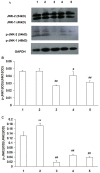Effect of reactive oxygen species generation in rabbit corneal epithelial cells on inflammatory and apoptotic signaling pathways in the presence of high osmotic pressure
- PMID: 23977369
- PMCID: PMC3744495
- DOI: 10.1371/journal.pone.0072900
Effect of reactive oxygen species generation in rabbit corneal epithelial cells on inflammatory and apoptotic signaling pathways in the presence of high osmotic pressure
Abstract
It is generally accepted that high osmotic pressure (HOP) of lacrimal fluid is the core mechanism causing ocular inflammation and injury. However, the association between HOP and the regulation of cell inflammatory response and apoptotic pathways remains unclear. In the present study, we used HOP to interfere with in vitro cultured rabbit corneal epithelial cells, and found that HOP increased the generation of reactive oxygen species (ROS) in rabbit corneal epithelial cells, and increased ROS in turn induced the activation of JNK inflammatory signaling pathway, which further promoted the expression of pro-inflammatory factor NF-κβ and induced the generation of inflammatory factor IL-1β and TNF-α. In addition, HOP-induced ROS in rabbit corneal epithelial cells regulated the CD95/CD95L-mediated cell apoptotic signaling pathway by activating JNK inflammatory signaling pathway. These findings may serve as new theoretical basis and a new way of thinking about the treatment of ocular diseases, especially dry eye.
Conflict of interest statement
Figures








Similar articles
-
Reactive oxygen species activated NLRP3 inflammasomes initiate inflammation in hyperosmolarity stressed human corneal epithelial cells and environment-induced dry eye patients.Exp Eye Res. 2015 May;134:133-40. doi: 10.1016/j.exer.2015.02.013. Epub 2015 Feb 18. Exp Eye Res. 2015. PMID: 25701684
-
Anti-inflammatory and anti-oxidative effects of the green tea polyphenol epigallocatechin gallate in human corneal epithelial cells.Mol Vis. 2011 Feb 18;17:533-42. Mol Vis. 2011. PMID: 21364905 Free PMC article.
-
Anti-Inflammatory and Anti-Apoptotic Effects of Acer Palmatum Thumb. Extract, KIOM-2015EW, in a Hyperosmolar-Stress-Induced In Vitro Dry Eye Model.Nutrients. 2018 Feb 28;10(3):282. doi: 10.3390/nu10030282. Nutrients. 2018. PMID: 29495608 Free PMC article.
-
Curcumin protects against hyperosmoticity-induced IL-1beta elevation in human corneal epithelial cell via MAPK pathways.Exp Eye Res. 2010 Mar;90(3):437-43. doi: 10.1016/j.exer.2009.12.004. Epub 2009 Dec 23. Exp Eye Res. 2010. PMID: 20026325
-
Non-apoptotic Fas signaling.Cytokine Growth Factor Rev. 2003 Feb;14(1):53-66. doi: 10.1016/s1359-6101(02)00072-2. Cytokine Growth Factor Rev. 2003. PMID: 12485619 Review.
Cited by
-
Protective Role of Epigallocatechin Gallate in a Rat Model of Cisplatin-Induced Cerebral Inflammation and Oxidative Damage: Impact of Modulating NF-κB and Nrf2.Neurotox Res. 2020 Feb;37(2):380-396. doi: 10.1007/s12640-019-00095-x. Epub 2019 Aug 13. Neurotox Res. 2020. PMID: 31410684
-
In Vitro Inhibition of NFAT5-Mediated Induction of CCL2 in Hyperosmotic Conditions by Cyclosporine and Dexamethasone on Human HeLa-Modified Conjunctiva-Derived Cells.PLoS One. 2016 Aug 3;11(8):e0159983. doi: 10.1371/journal.pone.0159983. eCollection 2016. PLoS One. 2016. PMID: 27486749 Free PMC article.
-
High glucose causes apoptosis of rabbit corneal epithelial cells involving activation of PERK-eIF2α-CHOP-caspase-12 signaling pathway.Int J Ophthalmol. 2019 Dec 18;12(12):1815-1822. doi: 10.18240/ijo.2019.12.01. eCollection 2019. Int J Ophthalmol. 2019. PMID: 31850162 Free PMC article.
-
High osmotic pressure increases reactive oxygen species generation in rabbit corneal epithelial cells by endoplasmic reticulum.Am J Transl Res. 2016 Feb 15;8(2):860-70. eCollection 2016. Am J Transl Res. 2016. PMID: 27158374 Free PMC article.
-
Ocular Application of Oleuropein in Dry Eye Treatment: Formulation Studies and Biological Evaluation.Pharmaceuticals (Basel). 2021 Nov 12;14(11):1151. doi: 10.3390/ph14111151. Pharmaceuticals (Basel). 2021. PMID: 34832933 Free PMC article.
References
-
- Liu H, Begley C, Chen M, Bradley A, Bonanno J, et al. (2009) A link between tear instability and hyperosmolarity in dry eye. Invest Ophthalmol Vis Sci 50: 3671–3679. - PubMed
-
- Bron AJ, Yokoi N, Gafney E, Tiffany JM (2009) Predicted phenotypes of dry eye: proposed consequences of its natural history. Ocul Surf 7: 78–92. - PubMed
-
- Luo L, Li DQ, Corrales RM, Pflugfelder SC (2005) Hyperosmolar saline is a proinflammatory stress on the mouse ocular surface. Eye Contact Lens 31: 186–193. - PubMed
-
- Perry HD (2008) Dry eye disease: pathophysiology, classification, and diagnosis. Am J Manag Care 14: S79–87. - PubMed
Publication types
MeSH terms
Substances
LinkOut - more resources
Full Text Sources
Other Literature Sources
Research Materials

